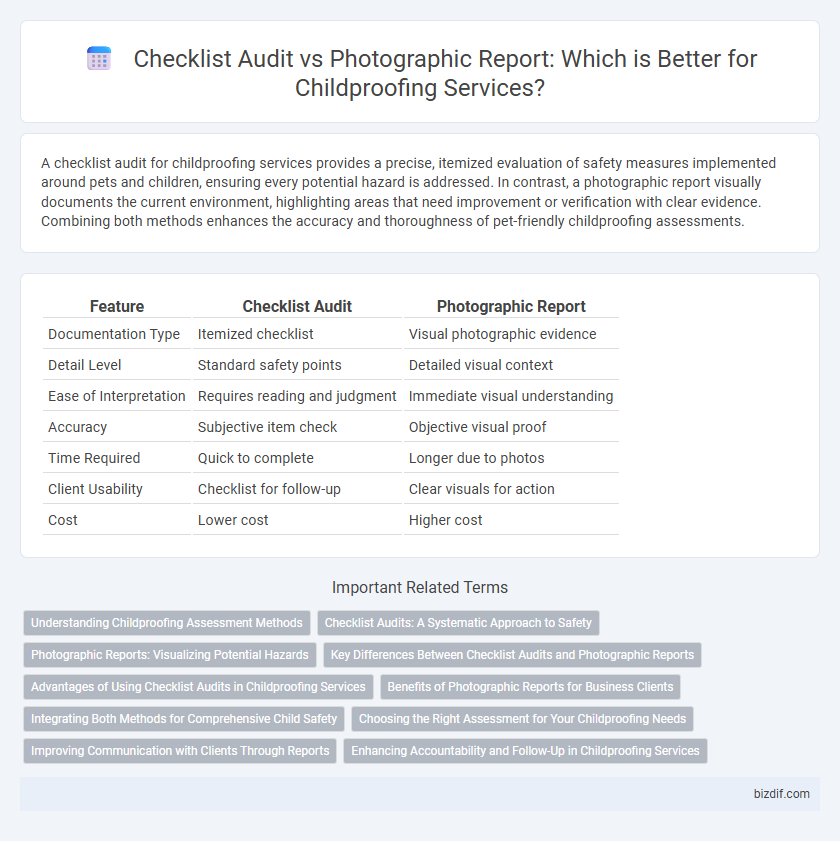A checklist audit for childproofing services provides a precise, itemized evaluation of safety measures implemented around pets and children, ensuring every potential hazard is addressed. In contrast, a photographic report visually documents the current environment, highlighting areas that need improvement or verification with clear evidence. Combining both methods enhances the accuracy and thoroughness of pet-friendly childproofing assessments.
Table of Comparison
| Feature | Checklist Audit | Photographic Report |
|---|---|---|
| Documentation Type | Itemized checklist | Visual photographic evidence |
| Detail Level | Standard safety points | Detailed visual context |
| Ease of Interpretation | Requires reading and judgment | Immediate visual understanding |
| Accuracy | Subjective item check | Objective visual proof |
| Time Required | Quick to complete | Longer due to photos |
| Client Usability | Checklist for follow-up | Clear visuals for action |
| Cost | Lower cost | Higher cost |
Understanding Childproofing Assessment Methods
A Checklist audit in childproofing involves systematically evaluating a space against a predefined list of safety criteria to identify potential hazards. A Photographic report enhances this process by providing visual documentation of identified risks, allowing for clearer communication and more precise follow-up actions. Understanding these assessment methods helps parents and caregivers make informed decisions to create a safer environment for children.
Checklist Audits: A Systematic Approach to Safety
Checklist audits provide a systematic approach to safety by ensuring every potential hazard in a childproofing environment is thoroughly evaluated against established safety standards. This method helps identify overlooked risks through detailed, itemized inspections that promote consistent compliance and effective risk mitigation. Incorporating checklist audits into childproofing services enhances overall safety assurance by delivering actionable, protocol-driven guidance for corrective measures.
Photographic Reports: Visualizing Potential Hazards
Photographic reports in childproofing services provide a clear, visual documentation of potential hazards, making it easier for parents and caregivers to identify and address risks. These reports capture detailed images of areas such as electrical outlets, furniture edges, and stairways, ensuring comprehensive hazard visualization. Visual evidence enhances communication with clients and supports effective implementation of safety measures.
Key Differences Between Checklist Audits and Photographic Reports
Checklist audits provide a structured, itemized review of childproofing elements, ensuring each safety standard is systematically evaluated against a predefined list. Photographic reports capture visual evidence of childproofing installations and potential hazards, offering concrete proof and easier identification of issues through images. The main difference lies in the checklist's focus on compliance and completeness, while photographic reports emphasize visual documentation and immediate hazard recognition.
Advantages of Using Checklist Audits in Childproofing Services
Checklist audits in childproofing services provide a systematic approach to identifying potential hazards, ensuring comprehensive coverage of safety measures tailored to each home environment. These audits facilitate clear communication between service providers and clients by highlighting specific safety steps completed or needed, which enhances accountability and trust. Utilizing checklist audits streamlines compliance with child safety regulations, promoting a safer living space through detailed, verifiable documentation of childproofing efforts.
Benefits of Photographic Reports for Business Clients
Photographic reports provide business clients with clear, visual documentation of childproofing compliance, enhancing accuracy and accountability during audits. These images offer undeniable proof of safety measures implemented, reducing disputes and supporting risk management strategies. Visual evidence speeds up reporting processes and improves communication with stakeholders, ensuring higher confidence in child safety standards.
Integrating Both Methods for Comprehensive Child Safety
Integrating a checklist audit with a photographic report ensures a comprehensive approach to childproofing by combining systematic itemization with visual evidence of safety measures. The checklist audit verifies that all safety points are addressed, while photographic documentation provides clear proof of compliance and highlights areas needing improvement. This dual method enhances accuracy, accountability, and peace of mind for parents seeking thorough child safety assessments.
Choosing the Right Assessment for Your Childproofing Needs
A Checklist audit provides a systematic evaluation of potential hazards in your home, ensuring all safety measures are addressed for comprehensive childproofing. A Photographic report offers visual documentation, highlighting specific risk areas with clear images that aid in understanding and prioritizing necessary modifications. Selecting the right assessment depends on whether you prefer detailed itemized guidance or visual evidence to support effective childproofing decisions.
Improving Communication with Clients Through Reports
A Checklist audit provides a structured list of childproofing elements verified during the inspection, ensuring clients understand what has been reviewed and addressed. A Photographic report visually documents key safety features and potential hazards, offering clear evidence that enhances transparency and trust. Combining both methods improves communication by delivering detailed, easily interpretable information tailored to client needs.
Enhancing Accountability and Follow-Up in Childproofing Services
A Checklist audit serves as a structured tool for systematically verifying that all childproofing measures meet established safety standards, ensuring thorough accountability in service delivery. In contrast, a Photographic report provides visual evidence of completed safety installations, facilitating clear follow-up actions and documentation for both service providers and clients. Combining these methods enhances transparency, supports precise communication, and strengthens long-term child safety compliance.
Checklist audit vs Photographic report Infographic

 bizdif.com
bizdif.com